Jackson M.J. Micro and Nanomanufacturing
Подождите немного. Документ загружается.

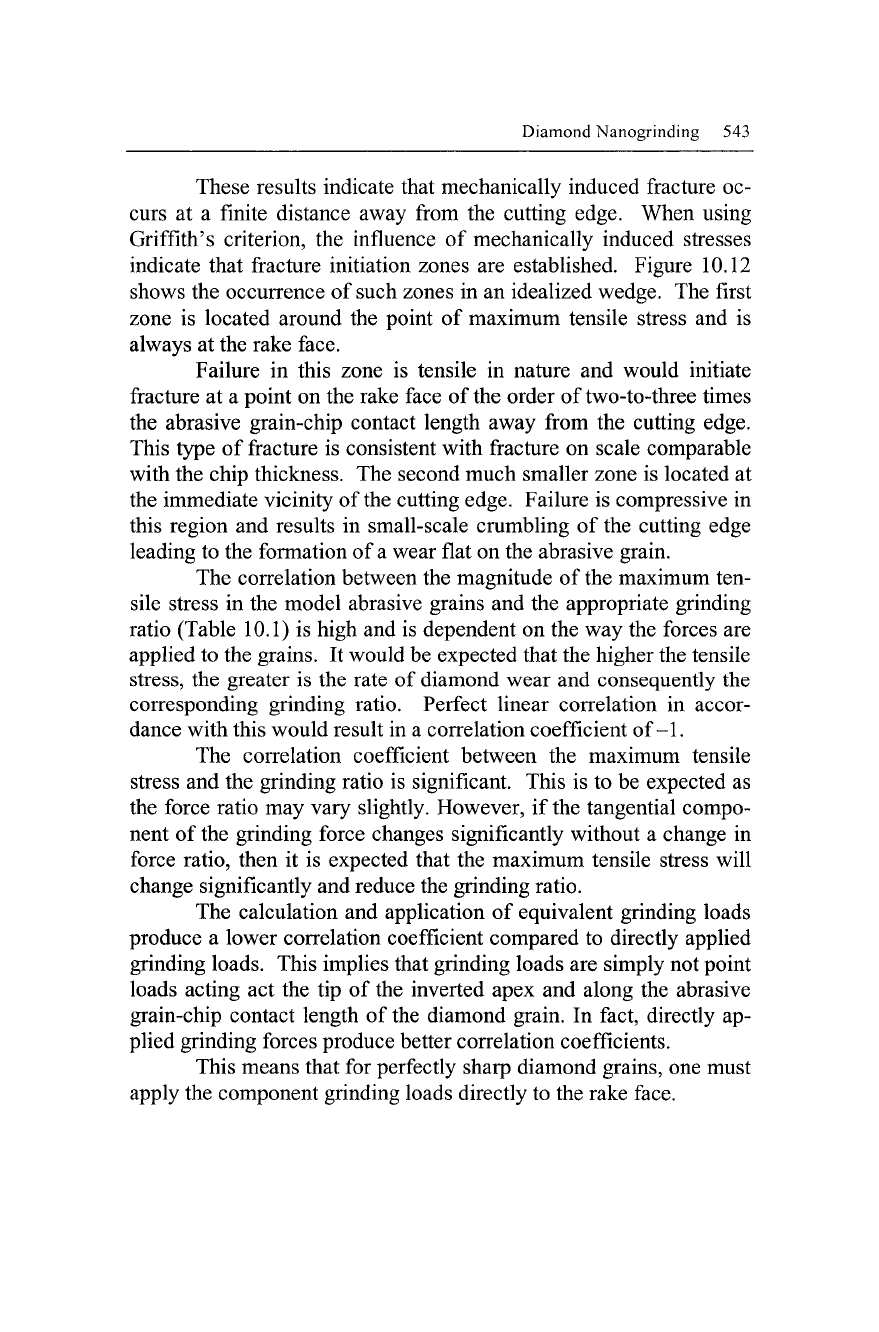
Diamond Nanogrinding 543
These results indicate that mechanically induced fracture oc-
curs at a finite distance away from the cutting edge. When using
Griffith's criterion, the influence of mechanically induced stresses
indicate that fracture initiation zones are established. Figure 10.12
shows the occurrence of such zones in an idealized wedge. The first
zone is located around the point of maximum tensile stress and is
always at the rake face.
Failure in this zone is tensile in nature and would initiate
fracture at a point on the rake face of the order of two-to-three times
the abrasive grain-chip contact length away from the cutting edge.
This type of fracture is consistent with fracture on scale comparable
with the chip thickness. The second much smaller zone is located at
the immediate vicinity of the cutting edge. Failure is compressive in
this region and results in small-scale crumbling of the cutting edge
leading to the formation of
a
wear flat on the abrasive grain.
The correlation between the magnitude of the maximum ten-
sile stress in the model abrasive grains and the appropriate grinding
ratio (Table 10.1) is high and is dependent on the way the forces are
applied to the grains. It would be expected that the higher the tensile
stress,
the greater is the rate of diamond wear and consequently the
corresponding grinding ratio. Perfect linear correlation in accor-
dance with this would result in a correlation coefficient of-1.
The correlation coefficient between the maximum tensile
stress and the grinding ratio is significant. This is to be expected as
the force ratio may vary slightly. However, if the tangential compo-
nent of the grinding force changes significantly without a change in
force ratio, then it is expected that the maximum tensile stress will
change significantly and reduce the grinding ratio.
The calculation and application of equivalent grinding loads
produce a lower correlation coefficient compared to directly applied
grinding loads. This implies that grinding loads are simply not point
loads acting act the tip of the inverted apex and along the abrasive
grain-chip contact length of the diamond grain. In fact, directly ap-
plied grinding forces produce better correlation coefficients.
This means that for perfectly sharp diamond grains, one must
apply the component grinding loads directly to the rake face.
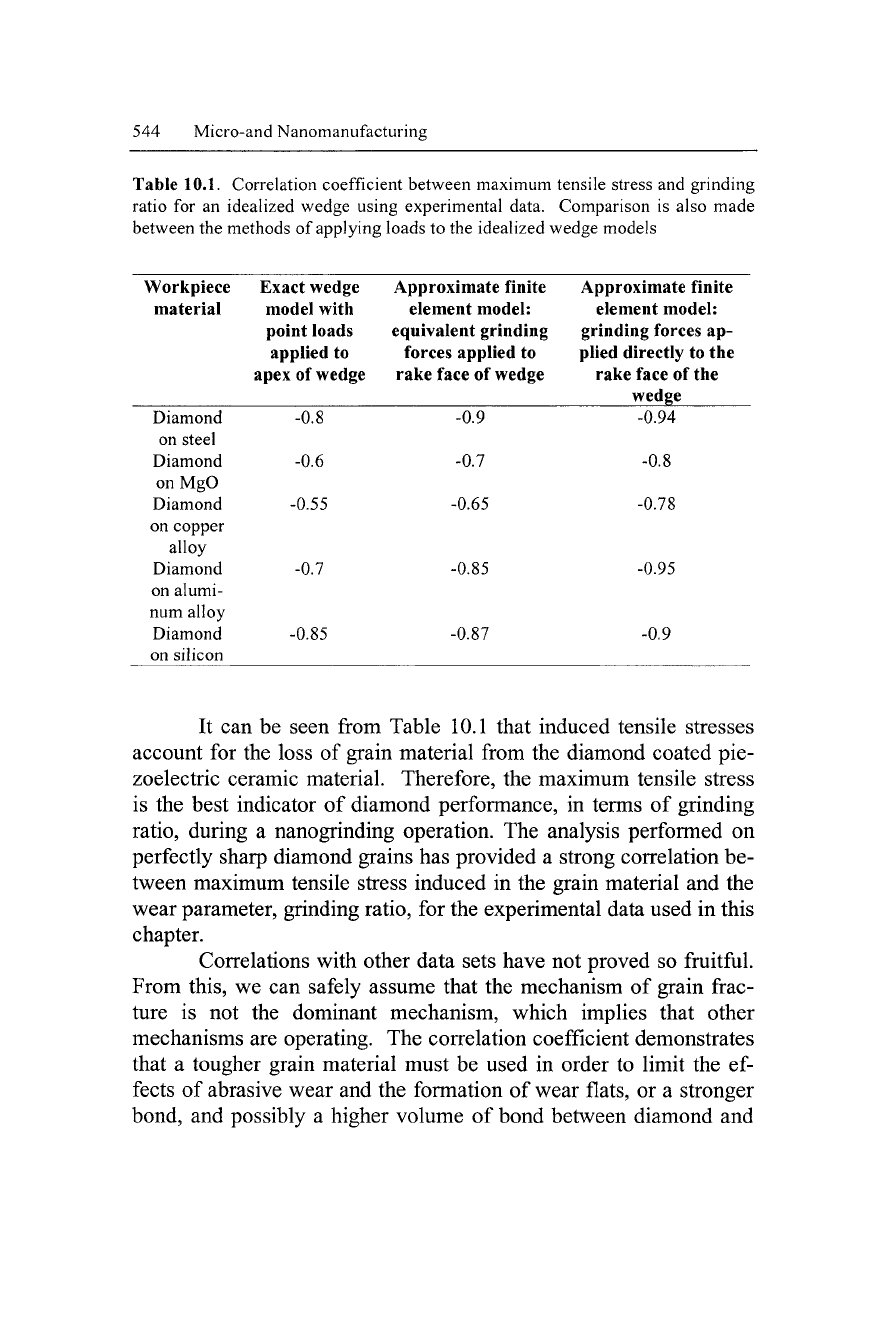
544 Micro-and Nanomanufacturing
Table 10.1. Correlation coefficient between maximum tensile stress and grinding
ratio for an idealized wedge using experimental data. Comparison is also made
between the methods of applying loads to the idealized wedge models
Workpiece
material
Diamond
on steel
Diamond
on MgO
Diamond
on copper
alloy
Diamond
on alumi-
num alloy
Diamond
on silicon
Exact wedge
model with
point loads
applied to
apex of wedge
-0.8
-0.6
-0.55
-0.7
-0.85
Approximate finite
element model:
equivalent grinding
forces applied to
rake face of wedge
^09~
"
-0.7
-0.65
-0.85
-0.87
Approximate finite
element model:
grinding forces ap-
plied directly to the
rake face of the
wedge
-0.94
-0.8
-0.78
-0.95
-0.9
It can be seen from Table 10.1 that induced tensile stresses
account for the loss of grain material from the diamond coated pie-
zoelectric ceramic material. Therefore, the maximum tensile stress
is the best indicator of diamond performance, in terms of grinding
ratio,
during a nanogrinding operation. The analysis performed on
perfectly sharp diamond grains has provided a strong correlation be-
tween maximum tensile stress induced in the grain material and the
wear parameter, grinding ratio, for the experimental data used in this
chapter.
Correlations with other data sets have not proved so fruitful.
From this, we can safely assume that the mechanism of grain frac-
ture is not the dominant mechanism, which implies that other
mechanisms are operating. The correlation coefficient demonstrates
that a tougher grain material must be used in order to limit the ef-
fects of abrasive wear and the formation of wear flats, or a stronger
bond, and possibly a higher volume of bond between diamond and
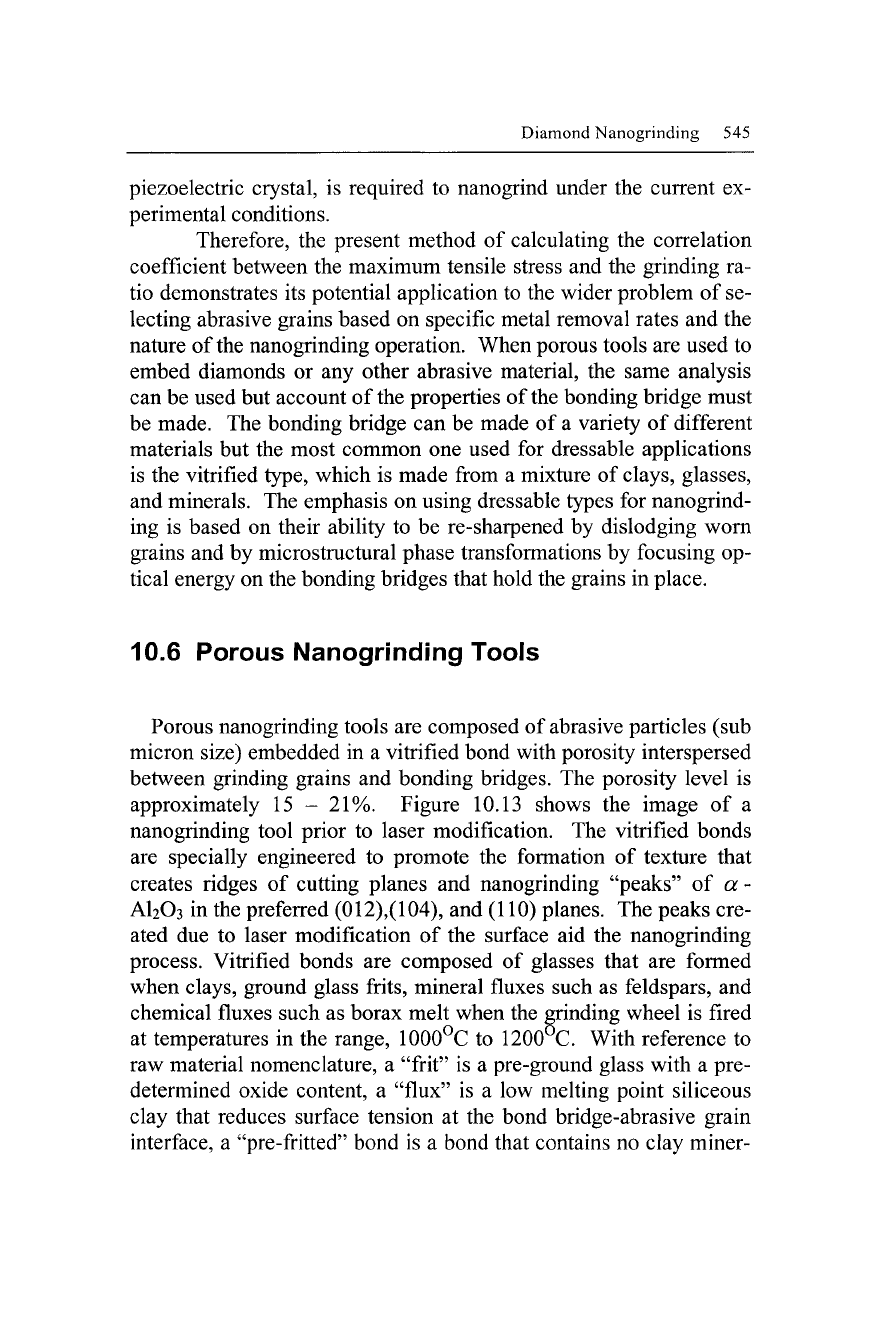
Diamond Nanogrinding 545
piezoelectric crystal, is required to nanogrind under the current ex-
perimental conditions.
Therefore, the present method of calculating the correlation
coefficient between the maximum tensile stress and the grinding ra-
tio demonstrates its potential application to the wider problem of se-
lecting abrasive grains based on specific metal removal rates and the
nature of the nanogrinding operation. When porous tools are used to
embed diamonds or any other abrasive material, the same analysis
can be used but account of the properties of the bonding bridge must
be made. The bonding bridge can be made of a variety of different
materials but the most common one used for dressable applications
is the vitrified type, which is made from a mixture of clays, glasses,
and minerals. The emphasis on using dressable types for nanogrind-
ing is based on their ability to be re-sharpened by dislodging worn
grains and by microstructural phase transformations by focusing op-
tical energy on the bonding bridges that hold the grains in place.
10.6 Porous Nanogrinding Tools
Porous nanogrinding tools are composed of abrasive particles (sub
micron size) embedded in a vitrified bond with porosity interspersed
between grinding grains and bonding bridges. The porosity level is
approximately 15 - 21%. Figure 10.13 shows the image of a
nanogrinding tool prior to laser modification. The vitrified bonds
are specially engineered to promote the formation of texture that
creates ridges of cutting planes and nanogrinding "peaks" of a -
AI2O3 in the preferred (012),(104), and (110) planes. The peaks cre-
ated due to laser modification of the surface aid the nanogrinding
process. Vitrified bonds are composed of glasses that are formed
when clays, ground glass frits, mineral fluxes such as feldspars, and
chemical fluxes such as borax melt when the grinding wheel is fired
at temperatures in the range, 1000°C to 1200 C. With reference to
raw material nomenclature, a "frit" is a pre-ground glass with a pre-
determined oxide content, a "flux" is a low melting point siliceous
clay that reduces surface tension at the bond bridge-abrasive grain
interface, a "pre-fritted" bond is a bond that contains no clay miner-
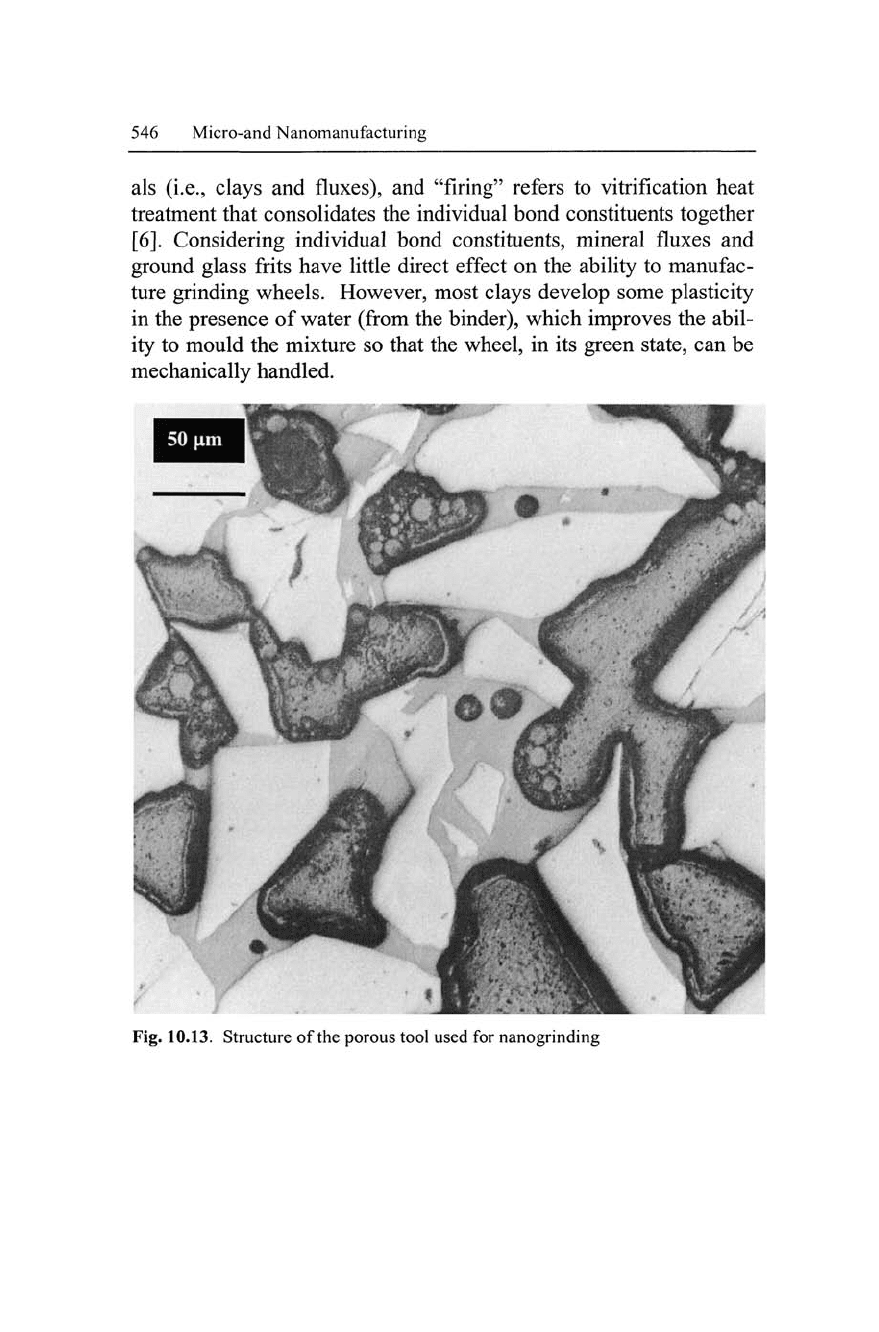
546 Micro-and Nanomanufacturing
als (i.e., clays and fluxes), and "firing" refers to vitrification heat
treatment that consolidates the individual bond constituents together
[6].
Considering individual bond constituents, mineral fluxes and
ground glass frits have little direct effect on the ability to manufac-
ture grinding wheels. However, most clays develop some plasticity
in the presence of water (from the binder), which improves the abil-
ity to mould the mixture so that the wheel, in its green state, can be
mechanically handled.
Fig.
10.13.
Structure of the porous tool used for nanogrinding
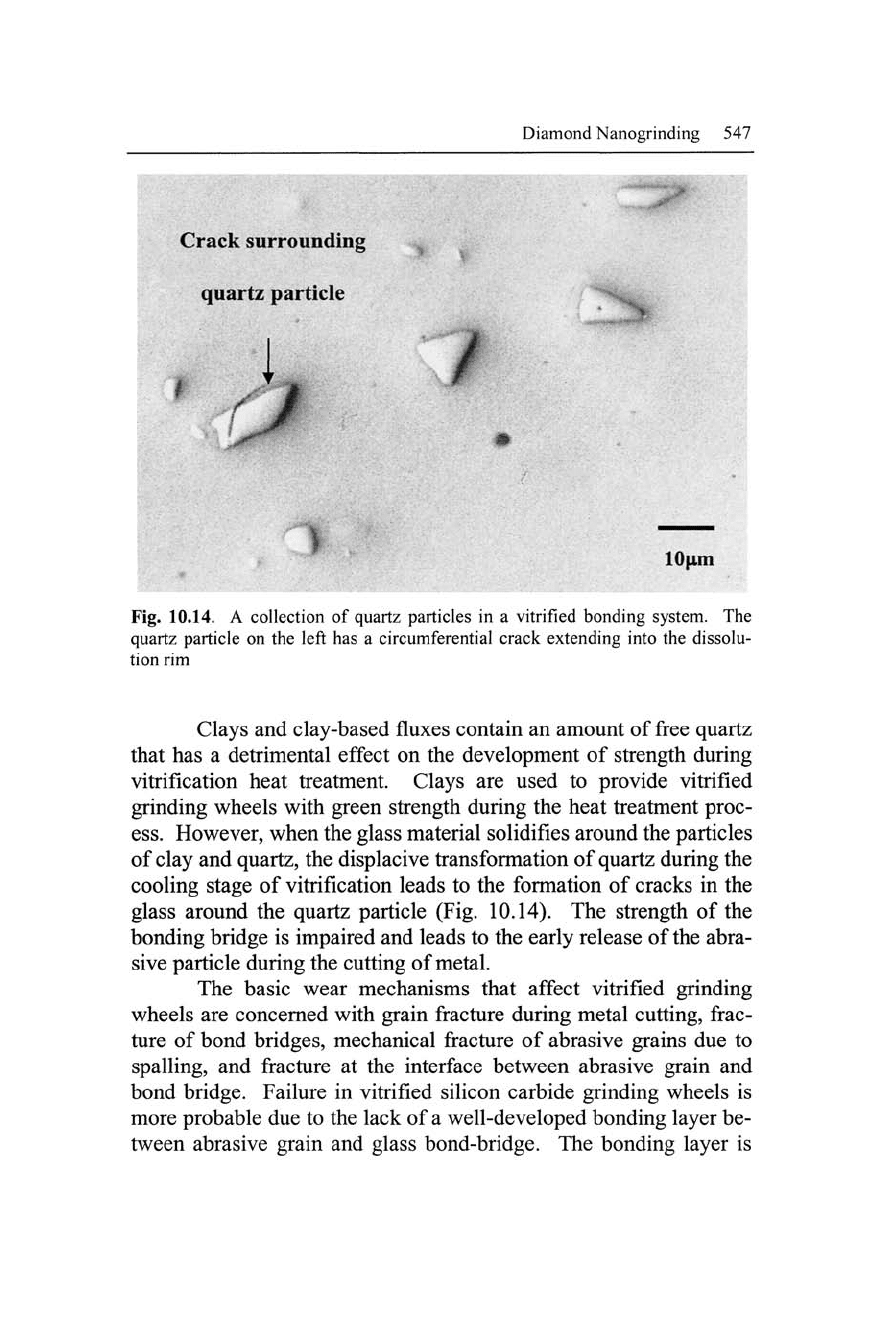
Diamond Nanogrinding 547
Crack surrounding
quartz particle
<
lOjim
Fig. 10.14. A collection of quartz particles in a vitrified bonding system. The
quartz particle on the left has a circumferential crack extending into the dissolu-
tion rim
Clays and clay-based fluxes contain an amount of free quartz
that has a detrimental effect on the development of strength during
vitrification heat treatment. Clays are used to provide vitrified
grinding wheels with green strength during the heat treatment proc-
ess.
However, when the glass material solidifies around the particles
of clay and quartz, the displacive transformation of quartz during the
cooling stage of vitrification leads to the formation of cracks in the
glass around the quartz particle (Fig. 10.14). The strength of the
bonding bridge is impaired and leads to the early release of the abra-
sive particle during the cutting of metal.
The basic wear mechanisms that affect vitrified grinding
wheels are concerned with grain fracture during metal cutting, frac-
ture of bond bridges, mechanical fracture of abrasive grains due to
spalling, and fracture at the interface between abrasive grain and
bond bridge. Failure in vitrified silicon carbide grinding wheels is
more probable due to the lack of a well-developed bonding layer be-
tween abrasive grain and glass bond-bridge. The bonding layer is
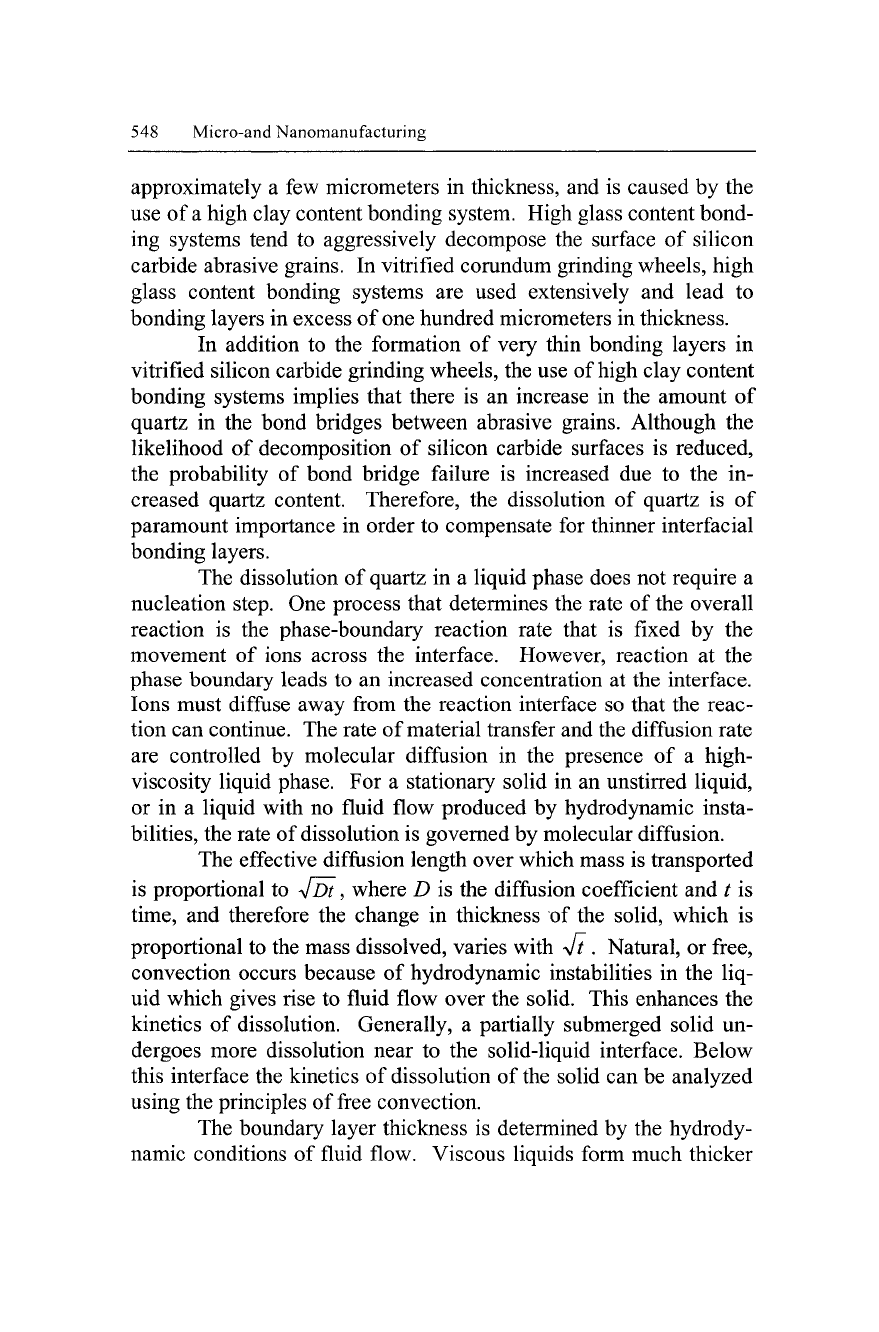
548 Micro-and Nanomanufacturing
approximately a few micrometers in thickness, and is caused by the
use of a high clay content bonding system. High glass content bond-
ing systems tend to aggressively decompose the surface of silicon
carbide abrasive grains. In vitrified corundum grinding wheels, high
glass content bonding systems are used extensively and lead to
bonding layers in excess of one hundred micrometers in thickness.
In addition to the formation of very thin bonding layers in
vitrified silicon carbide grinding wheels, the use of high clay content
bonding systems implies that there is an increase in the amount of
quartz in the bond bridges between abrasive grains. Although the
likelihood of decomposition of silicon carbide surfaces is reduced,
the probability of bond bridge failure is increased due to the in-
creased quartz content. Therefore, the dissolution of quartz is of
paramount importance in order to compensate for thinner interfacial
bonding layers.
The dissolution of quartz in a liquid phase does not require a
nucleation step. One process that determines the rate of the overall
reaction is the phase-boundary reaction rate that is fixed by the
movement of ions across the interface. However, reaction at the
phase boundary leads to an increased concentration at the interface.
Ions must diffuse away from the reaction interface so that the reac-
tion can continue. The rate of material transfer and the diffusion rate
are controlled by molecular diffusion in the presence of a high-
viscosity liquid phase. For a stationary solid in an unstirred liquid,
or in a liquid with no fluid flow produced by hydrodynamic insta-
bilities, the rate of dissolution is governed by molecular diffusion.
The effective diffusion length over which mass is transported
is proportional to ^Dt, where D is the diffusion coefficient and / is
time,
and therefore the change in thickness of the solid, which is
proportional to the mass dissolved, varies with Natural, or free,
convection occurs because of hydrodynamic instabilities in the liq-
uid which gives rise to fluid flow over the solid. This enhances the
kinetics of dissolution. Generally, a partially submerged solid un-
dergoes more dissolution near to the solid-liquid interface. Below
this interface the kinetics of dissolution of the solid can be analyzed
using the principles of free convection.
The boundary layer thickness is determined by the hydrody-
namic conditions of fluid flow. Viscous liquids form much thicker
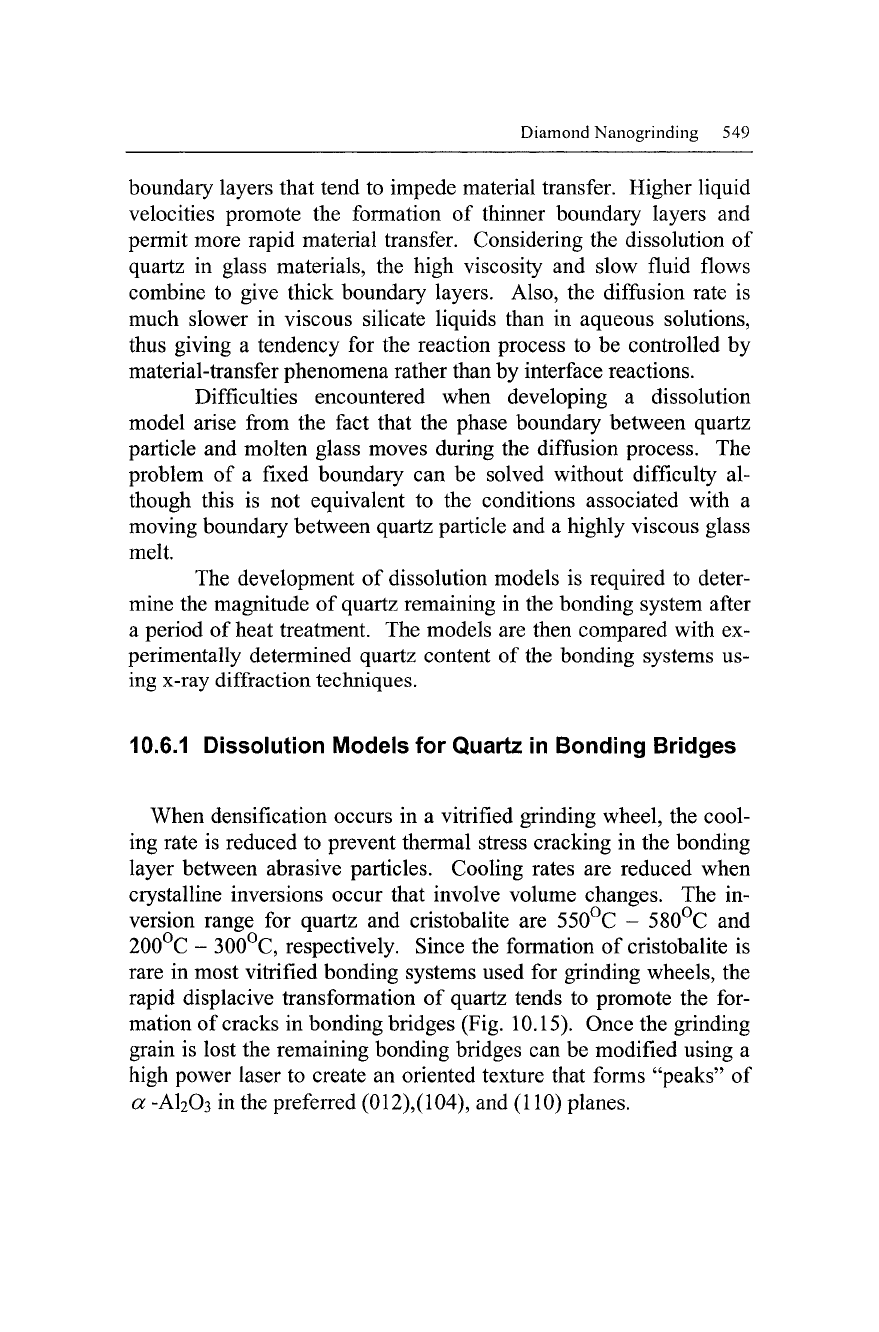
Diamond Nanogrinding 549
boundary layers that tend to impede material transfer. Higher liquid
velocities promote the formation of thinner boundary layers and
permit more rapid material transfer. Considering the dissolution of
quartz in glass materials, the high viscosity and slow fluid flows
combine to give thick boundary layers. Also, the diffusion rate is
much slower in viscous silicate liquids than in aqueous solutions,
thus giving a tendency for the reaction process to be controlled by
material-transfer phenomena rather than by interface reactions.
Difficulties encountered when developing a dissolution
model arise from the fact that the phase boundary between quartz
particle and molten glass moves during the diffusion process. The
problem of a fixed boundary can be solved without difficulty al-
though this is not equivalent to the conditions associated with a
moving boundary between quartz particle and a highly viscous glass
melt.
The development of dissolution models is required to deter-
mine the magnitude of quartz remaining in the bonding system after
a period of heat treatment. The models are then compared with ex-
perimentally determined quartz content of the bonding systems us-
ing x-ray diffraction techniques.
10.6.1 Dissolution Models for Quartz in Bonding Bridges
When densification occurs in a vitrified grinding wheel, the cool-
ing rate is reduced to prevent thermal stress cracking in the bonding
layer between abrasive particles. Cooling rates are reduced when
crystalline inversions occur that involve volume changes. The in-
version range for quartz and cristobalite are 550°C - 580°C and
200°C - 300°C, respectively. Since the formation of cristobalite is
rare in most vitrified bonding systems used for grinding wheels, the
rapid displacive transformation of quartz tends to promote the for-
mation of cracks in bonding bridges (Fig. 10.15). Once the grinding
grain is lost the remaining bonding bridges can be modified using a
high power laser to create an oriented texture that forms "peaks" of
a -A1
2
0
3
in the preferred (012),(104), and (110) planes.
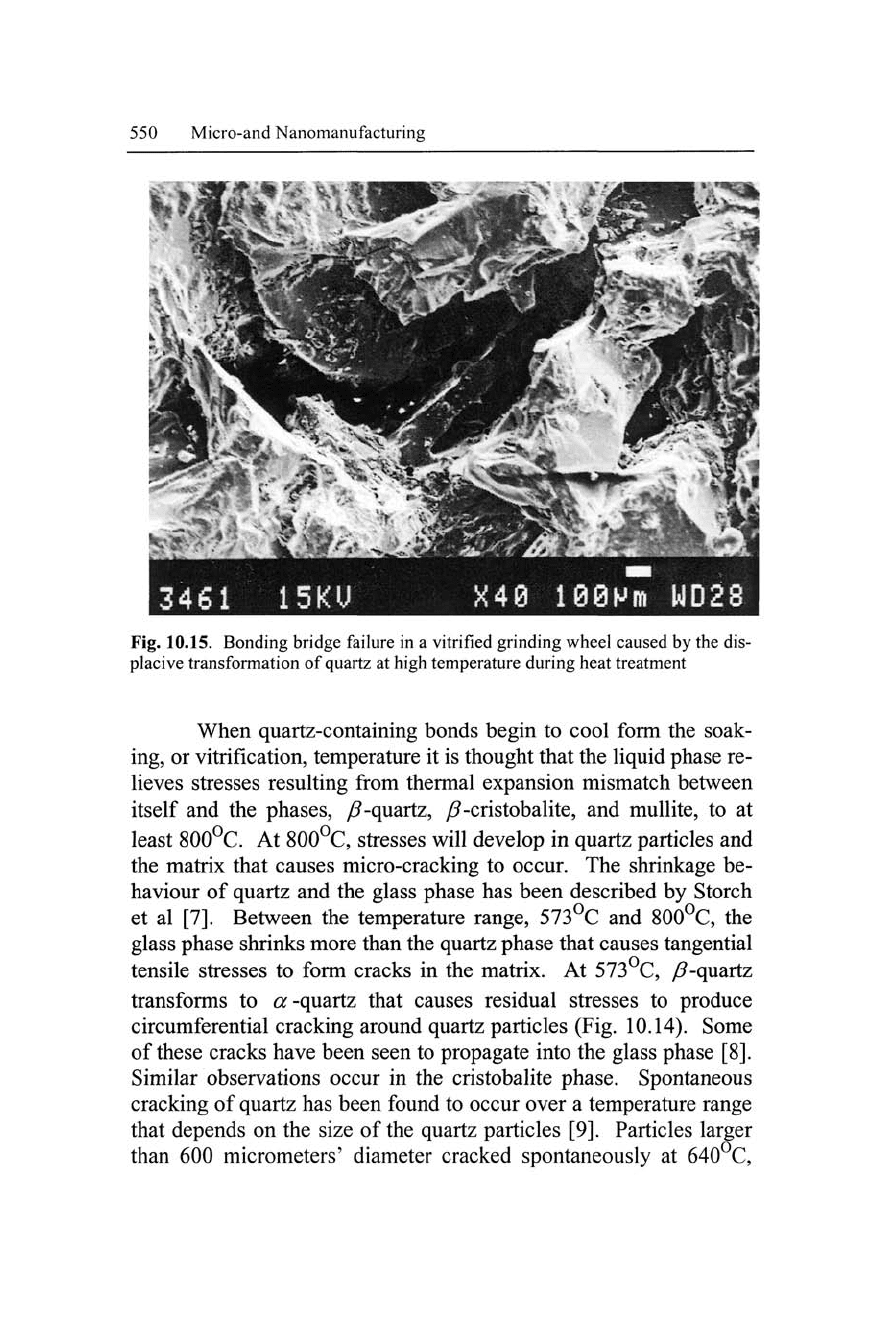
550 Micro-and Nanomanufacturing
Fig. 10.15. Bonding bridge failure in a vitrified grinding wheel caused by the dis-
placive transformation of quartz at high temperature during heat treatment
When quartz-containing bonds begin to cool form the soak-
ing, or vitrification, temperature it is thought that the liquid phase re-
lieves stresses resulting from thermal expansion mismatch between
itself and the phases, J3-quartz, /?-cristobalite, and mullite, to at
least 800°C. At 800°C, stresses will develop in quartz particles and
the matrix that causes micro-cracking to occur. The shrinkage be-
haviour of quartz and the glass phase has been described by Storch
et al [7]. Between the temperature range, 573°C and 800°C, the
glass phase shrinks more than the quartz phase that causes tangential
tensile stresses to form cracks in the matrix. At 573°C, J3-quartz
transforms to a-quartz that causes residual stresses to produce
circumferential cracking around quartz particles (Fig. 10.14). Some
of these cracks have been seen to propagate into the glass phase [8].
Similar observations occur in the cristobalite phase. Spontaneous
cracking of quartz has been found to occur over a temperature range
that depends on the size of the quartz particles [9]. Particles larger
than 600 micrometers' diameter cracked spontaneously at 640°C,
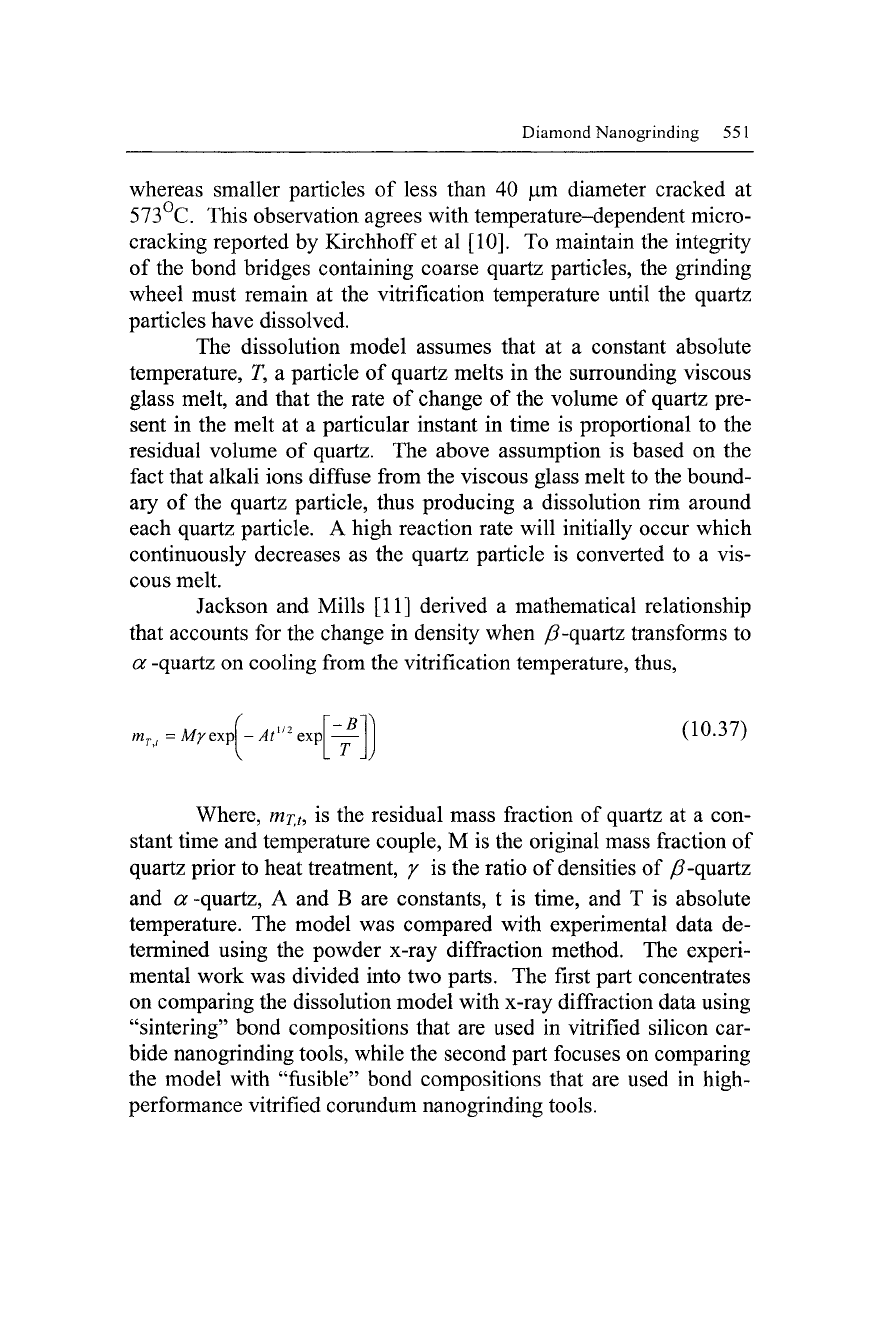
Diamond Nanogrinding 551
whereas smaller particles of less than 40 |nm diameter cracked at
573°C. This observation agrees with temperature-dependent micro-
cracking reported by Kirchhoff et al [10]. To maintain the integrity
of the bond bridges containing coarse quartz particles, the grinding
wheel must remain at the vitrification temperature until the quartz
particles have dissolved.
The dissolution model assumes that at a constant absolute
temperature, 7, a particle of quartz melts in the surrounding viscous
glass melt, and that the rate of change of the volume of quartz pre-
sent in the melt at a particular instant in time is proportional to the
residual volume of quartz. The above assumption is based on the
fact that alkali ions diffuse from the viscous glass melt to the bound-
ary of the quartz particle, thus producing a dissolution rim around
each quartz particle. A high reaction rate will initially occur which
continuously decreases as the quartz particle is converted to a vis-
cous melt.
Jackson and Mills [11] derived a mathematical relationship
that accounts for the change in density when j3-quartz transforms to
a -quartz on cooling from the vitrification temperature, thus,
M/exp -At
112
exp
(10.37)
Where, m^, is the residual mass fraction of quartz at a con-
stant time and temperature couple, M is the original mass fraction of
quartz prior to heat treatment, y is the ratio of densities of /? -quartz
and a -quartz, A and B are constants, t is time, and T is absolute
temperature. The model was compared with experimental data de-
termined using the powder x-ray diffraction method. The experi-
mental work was divided into two parts. The first part concentrates
on comparing the dissolution model with x-ray diffraction data using
"sintering" bond compositions that are used in vitrified silicon car-
bide nanogrinding tools, while the second part focuses on comparing
the model with "fusible" bond compositions that are used in high-
performance vitrified corundum nanogrinding tools.
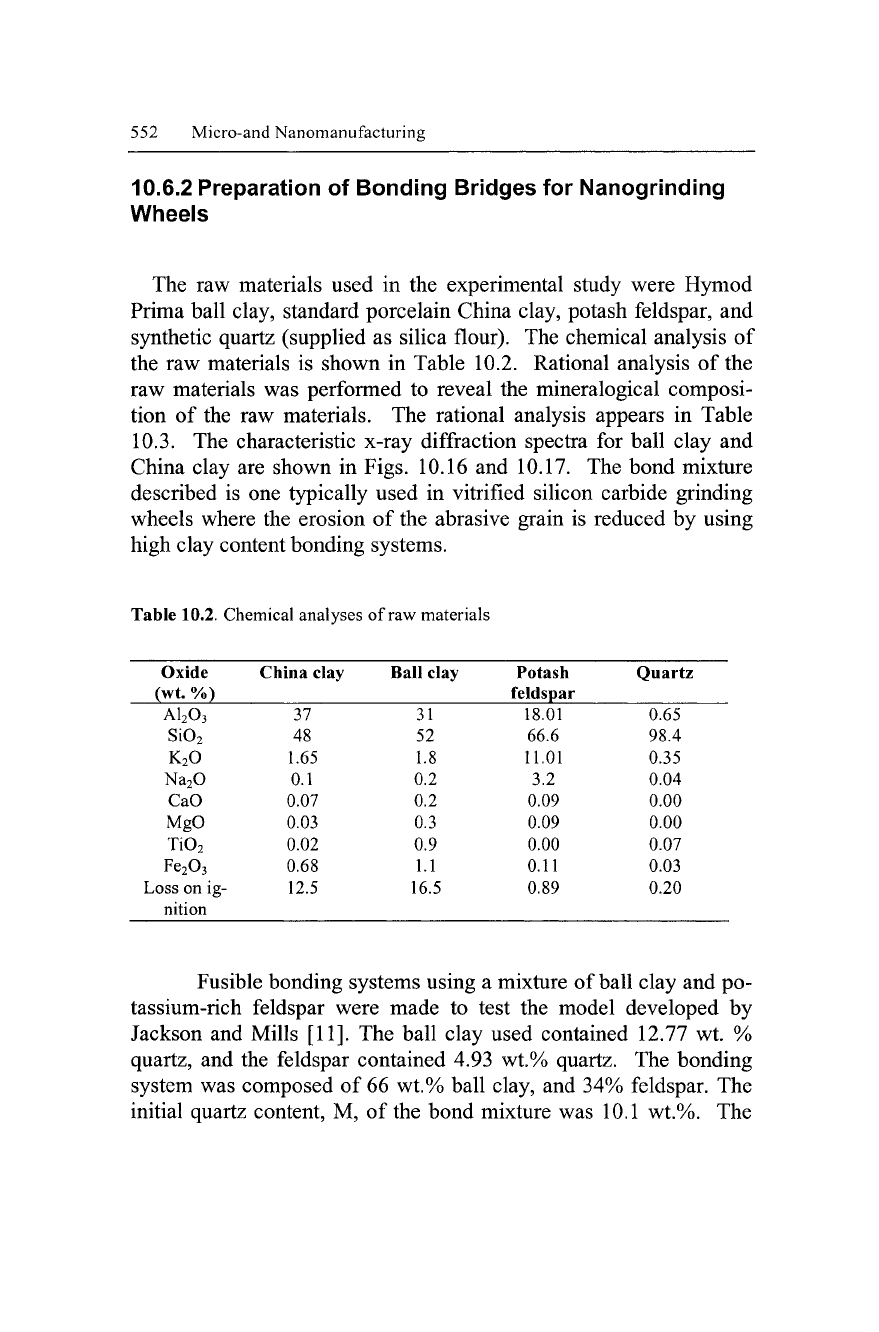
552 Micro-and Nanomanufacturing
10.6.2 Preparation of Bonding Bridges for Nanogrinding
Wheels
The raw materials used in the experimental study were Hymod
Prima ball clay, standard porcelain China clay, potash feldspar, and
synthetic quartz (supplied as silica flour). The chemical analysis of
the raw materials is shown in Table 10.2. Rational analysis of the
raw materials was performed to reveal the mineralogical composi-
tion of the raw materials. The rational analysis appears in Table
10.3.
The characteristic x-ray diffraction spectra for ball clay and
China clay are shown in Figs. 10.16 and 10.17. The bond mixture
described is one typically used in vitrified silicon carbide grinding
wheels where the erosion of the abrasive grain is reduced by using
high clay content bonding systems.
Table 10.2. Chemical analyses of raw materials
Oxide
(wt. %)
A1
2
0
3
Si0
2
K
2
0
Na
2
0
CaO
MgO
Ti0
2
Fe
2
0
3
Loss on ig-
nition
China clay
37
48
1.65
0.1
0.07
0.03
0.02
0.68
12.5
Ball clay
31
52
1.8
0.2
0.2
0.3
0.9
1.1
16.5
Potash
feldspar
18.01
66.6
11.01
3.2
0.09
0.09
0.00
0.11
0.89
Quartz
0.65
98.4
0.35
0.04
0.00
0.00
0.07
0.03
0.20
Fusible bonding systems using a mixture of ball clay and po-
tassium-rich feldspar were made to test the model developed by
Jackson and Mills [11]. The ball clay used contained 12.77 wt. %
quartz, and the feldspar contained 4.93 wt.% quartz. The bonding
system was composed of 66 wt.% ball clay, and 34% feldspar. The
initial quartz content, M, of the bond mixture was 10.1 wt.%. The
